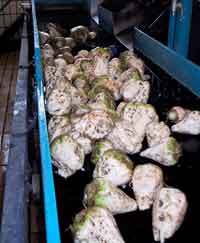Nematode resister a first for latest beet recommended list

The 2010 BBRO/NIAB Recommended List of sugar beet varieties contains only three new names, but among them is a first – a variety with beet cyst nematode (BCN) tolerance.
Rhizomania resistant Fiorenza KWS, from KWS, is provisionally recommended specifically for use only under BCN-infested conditions, says NIAB’s Simon Kerr.
BCN has largely been overlooked because, unlike potato cyst nematode (PCN), there is no economic pesticide treatment against it available, notes Mr Kerr.
But the pest could become more troublesome under tighter rotations, he warns. “It’s a bit of sleeping giant. We’ve generally learned to live with it. But it is an issue on some of the lighter soils in East Anglia.”
Strip trials in the UK supervised by Broom’s Barn and British Sugar have shown that Fiorenza KWS can boost yields on infested land by 23-50%, he noted. But it suffered a 10% yield penalty on clean ground in RL trials.
“It will be interesting to see how this variety performs under infested conditions.”
The other newcomers among the 17 listed names to choose from are Saracen, a conventional variety with high yield potential, and Aimanta. Both are from Syngenta, the latter being firm’s first recommended rhizomania resister.
All three additions need testing for two more years before potential promotion to becoming fully recommended.
“It’s a bit of a moderate year for new varieties,” says Mr Kerr. “We usually add six or seven each year, and we’ve had some good ones joining lately, for example, Carissima, Mandella and Sophia last year and Alota, Bullfinch and Trinita the year before.” But both Syngenta’s varieties yield on a par with those, he points out.
“Saracen is the second highest yielder on the list, and Aimanta is well up to the level of other rhizomania resistant varieties.”
Given the recent rise in rhizomania levels it is vital that the risk of the disease is assessed when choosing varieties, he stresses.
“It’s very evident that once you have infection, when you come back to crop with beet three years later it usually seems to have spread.”
Mr Kerr recommends that growers send plants from suspect areas in this season’s crops to Broom’s Barn’s rhizomania clinic for diagnosis to help guide future variety selection and control strategies.
In outbreak areas, particularly Norfolk and Suffolk, the disease is so widespread that resistant varieties, which now yield as well as others on clean land, are essential, he believes.
“But it’s worth remembering that there’s still a substantial acreage that doesn’t have rhizomania.”

